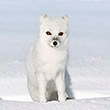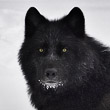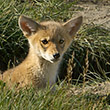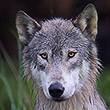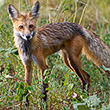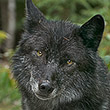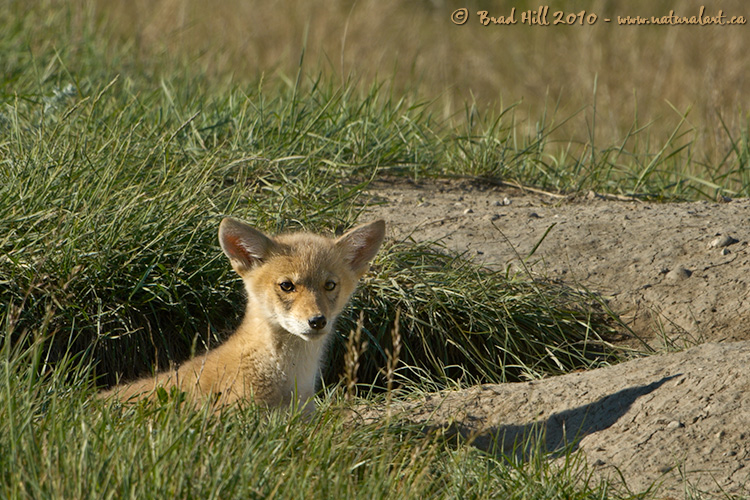
Availability: Undetermined - Enquiries?
In the Field
Coyote Pup Emerging From Den (or..."What's Wrong With This Picture?"). Calgary, AB, Canada. June 22, 2005 (image processed early in 2010).
As I write this commentary early in 2010, I live in a very remote area of southeast British Columbia and I'm totally surrounded by wilderness. Coyotes are exceptionally common and visit our property daily (and a couple may literally live on our property). BUT...the coyotes here are considered "varmints" by many of the locals and regularly shot at and killed. The end result? Any coyotes left alive are EXCEPTIONALLY wary of humans and one only catches fleeting glimpses of them as they run off (which, in my opinion, is an incredible shame and leaves me a little embarrassed to be a human).
So...how did I manage to capture this image of a very young coyote (about 12 weeks old) emerging from its den? I went to the big city, of course! Calgary, Alberta is like any other major city in North America and discourages the discharge of firearms within the city limits. And, it has a lot of coyotes and they're amazingly approachable compared to their rural relatives. I found this den after only a couple hours of searching (and I've been searching for one near my home in BC for years!) and I only had to wait a short time for the pups to start emerging. The irony associated with a rural-living wildlife photographer having to travel to the city to photograph wildlife is NOT lost on me!
Behind the Camera
Coyote Pup Emerging From Den (or..."What's Wrong With This Picture?"). Calgary, AB, Canada. June 22, 2005 (image processed early in 2010).
Digital Capture; Compressed RAW (NEF) format; ISO 100.
Nikon D2X with Nikon 200-400 mm f/4G ED-IF AF-S VR lens @ 400 mm (600 mm EFL) supported on Gitzo 1348 carbon fibre tripod with Wimberley head. VR turned to "On" and in "Normal" mode.
1/125s @ f10; -0.67 stop compensation from matrix-metered exposure setting (to retain highlight detail on sunlit portions of the pup's head).
At the Computer
Coyote Pup Emerging From Den (or..."What's Wrong With This Picture?"). Calgary, AB, Canada. June 22, 2005 (image processed early in 2010).
RAW Conversion, including first-pass sharpening, using Phase One's C1 Pro 5.0.2. Three raw conversions at different exposure settings to balance final exposure. Raw conversions at -0.33 stops (to retrieve highlight detail on side of pup's face) through to +0.25 stops (to retrieve shadow detail on shaded portions of the pup).
All further digital correction on 16-bit TIFF file using Adobe's Photoshop CS4 and Light Craft's LightZone 3.8.5. Photoshop adjustments included compositing (layer and masking) of 3 exposure variants, selective colour saturation and desaturation, and selective sharpening for web output. Final tone tweaking and adjustments using the Tonemapper/Re-light tool of LightZone.
Conservation
Coyote Pup Emerging From Den (or..."What's Wrong With This Picture?"). Calgary, AB, Canada. June 22, 2005 (image processed early in 2010).
Ten percent of the revenue generated by this image will be donated to Wildsight.
Species Status in Canada*: Not "Endangered" or "Threatened".
The Coyote (Canis latrans) is anything but endangered. Its historical range has expanded dramatically since the mid 1800's. This range expansion has been in parallel - in both time and space - with the range contraction of the Gray Wolf as it was extirpated over most of North America. Coyotes are now found in a huge array of habitats (including the centres of major cities) from Panama north to about 70 degrees N latitude. The key to the success of the coyote is primarily twofold. First, historically both local coyote populations as well as their overall geographic distribution were kept in check by Gray Wolves. As humans eradicated the wolves with deadly efficiency, more "safe" habitat became available. Second, coyotes exhibit a tremendously plastic behavioural repertoire than is continually expanding. In short, they're amazingly adaptable and intelligent. My hat is off to this clever and fascinating animal - it represents a true species success story. It also serves as a reminder that many factors influence population dynamics and that the removal of one species (in this case the wolf) can have completely unexpected consequences.
Wildsight is an effective conservation organization that protects biodiversity and promotes sustainable communities in Canada's Columbia and Rocky Mountains. Support for Wildsight, through donation or becoming a member, will help ensure that they remain effective in their efforts to conserve threatened or endangered species and ecosystems.
*as determined by COSEWIC: The Committee on the Status of Endangered Wildlife in Canada


















